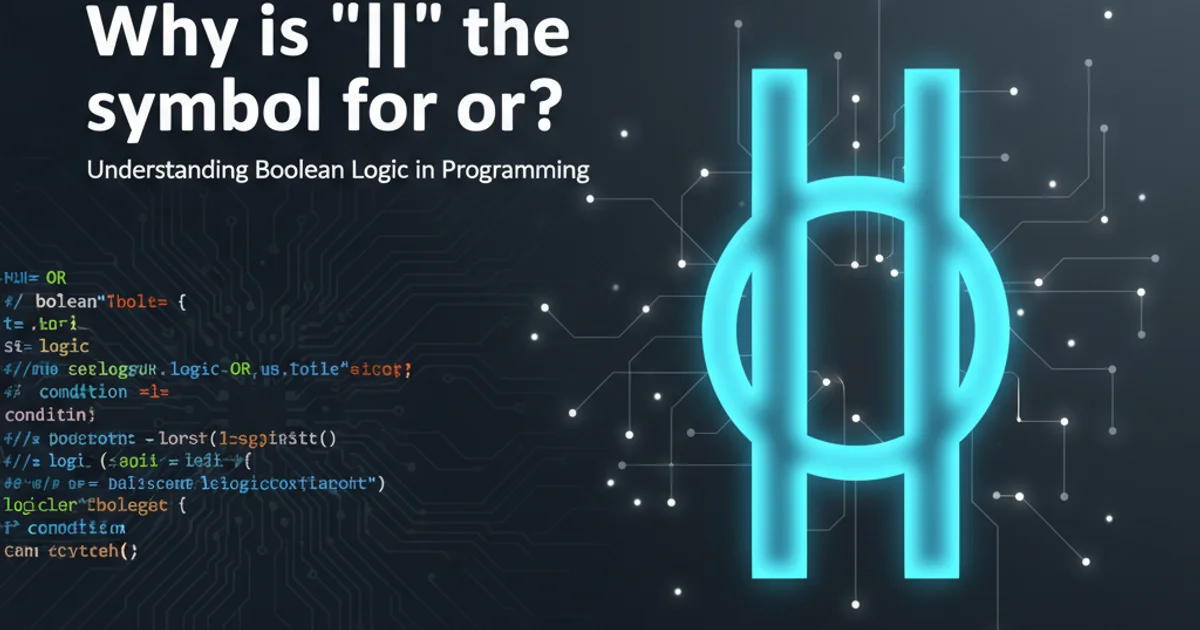Why is "||" the symbol for or?
Categories:
Unraveling the '||' Symbol: The History and Logic of the OR Operator

Explore the origins and evolution of '||' as the logical OR operator in programming languages, distinguishing it from its bitwise counterpart and understanding its practical applications.
The double pipe symbol, ||, is ubiquitous in programming as the logical OR operator. But why these two vertical lines? This article delves into the historical context, linguistic influences, and technical distinctions that led to || becoming the standard representation for logical disjunction across many programming languages. We'll explore its journey from early computing to modern syntax, differentiate it from the bitwise OR operator, and illustrate its practical use cases.
The Genesis of Logical Operators: From Mathematics to Computing
The concept of logical OR predates computing, rooted in mathematical logic and Boolean algebra. George Boole formalized these concepts in the mid-19th century, using symbols like + or ∨ for disjunction. Early programming languages needed a way to represent these logical operations. Single characters were often reserved for arithmetic or other fundamental operations, leading to the adoption of multi-character symbols for logical constructs.
The choice of || specifically can be traced back to the C programming language, which had a profound influence on subsequent languages like C++, Java, JavaScript, PHP, and many others. C's design aimed for efficiency and conciseness, often reusing existing ASCII characters. The single vertical bar | was already established for the bitwise OR operation. To distinguish the logical OR, which evaluates to a boolean true/false and often short-circuits, a distinct symbol was needed. Doubling the character provided this distinction.
flowchart TD
A["Boolean Logic (1800s)"] --> B["Early Programming Languages (1950s-60s)"]
B --> C["C Language Development (1970s)"]
C --> D{"Need for Logical OR Symbol"}
D --> E["Single '|' for Bitwise OR"]
D --> F["Double '||' for Logical OR"]
E & F --> G["Influence on Modern Languages"]
G --> H["Ubiquitous '||' Today"]Evolution of the '||' symbol for Logical OR
Distinguishing Logical OR (||) from Bitwise OR (|)
One of the most crucial aspects of understanding || is differentiating it from its single-bar counterpart, |. While both perform an 'OR' operation, their contexts and behaviors are fundamentally different.
| (bitwise OR) and || (logical OR). Using the wrong operator can lead to subtle and hard-to-debug errors, especially in conditional statements.Bitwise OR (|)
The bitwise OR operator works directly on the binary representations of its operands. It compares each bit position of two numbers and returns a new number where a bit is set to 1 if either corresponding bit in the operands is 1. It operates on integers and does not short-circuit.
int a = 5; // Binary: 0101
int b = 3; // Binary: 0011
int result = a | b; // Binary: 0111 (Decimal: 7)
printf("Bitwise OR of %d and %d is %d\n", a, b, result);
Example of Bitwise OR in C
Logical OR (||)
The logical OR operator, ||, operates on boolean expressions (or values that can be coerced to booleans). It returns true if at least one of its operands evaluates to true. A key characteristic of || in most languages is short-circuit evaluation. If the left-hand operand evaluates to true, the right-hand operand is not evaluated at all, because the overall result is already determined to be true.
let x = 10;
let y = 0;
if (x > 5 || y > 5) { // x > 5 is true, so y > 5 is not evaluated
console.log("At least one condition is true.");
}
function doSomething() {
console.log("Function called!");
return true;
}
false || doSomething(); // doSomething() is called
true || doSomething(); // doSomething() is NOT called due to short-circuiting
Example of Logical OR with short-circuiting in JavaScript
Practical Applications and Modern Usage
The || operator is fundamental for controlling program flow, validating inputs, and providing default values. Its short-circuiting behavior is particularly useful for efficiency and preventing errors.
Conditional Logic
The most common use is in if statements, while loops, and other conditional constructs to check if any of several conditions are met.
age = 17
has_permission = False
if age >= 18 or has_permission: # Evaluates to false
print("Access granted.")
else:
print("Access denied.")
Using logical OR for conditional access in Python
Providing Default Values (Common in JavaScript)
Due to its short-circuiting nature, || is often used to provide a fallback or default value if the first operand is 'falsy' (e.g., null, undefined, 0, '', false).
function greet(name) {
const userName = name || "Guest"; // If name is falsy, userName becomes "Guest"
console.log(`Hello, ${userName}!`);
}
greet("Alice"); // Output: Hello, Alice!
greet(null); // Output: Hello, Guest!
greet(""); // Output: Hello, Guest!
Using logical OR for default parameter values in JavaScript
|| for default values is common in JavaScript, be aware that 0 and '' (empty string) are also falsy. If 0 or '' are valid inputs, consider using the nullish coalescing operator ?? (if available in your language) or explicit checks instead.